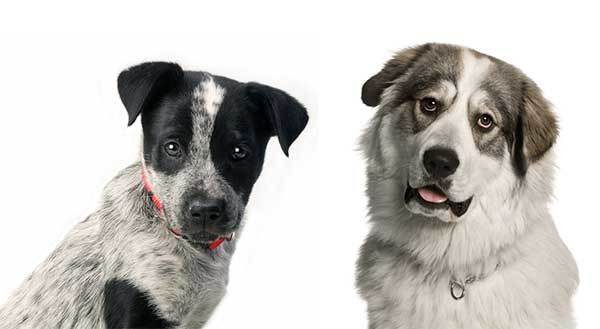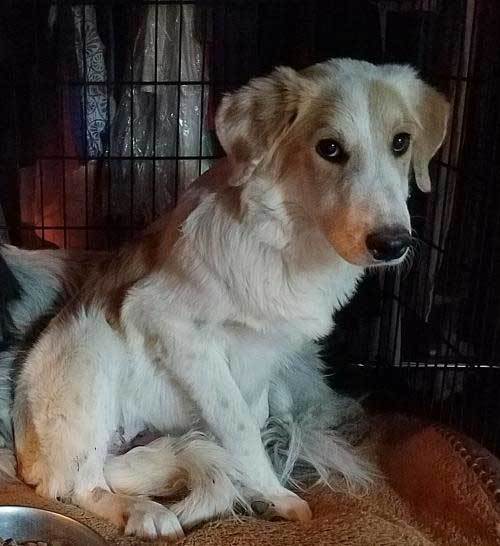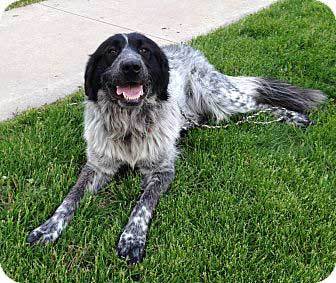As its name suggests, the Great Pyrenees Blue Heeler Mix is a cross between the Great Pyrenees and the Blue Heeler.
Although all crossbreeds can vary in appearance, the Great Pyrenees Blue Heeler Mix should be a large and energetic dog. You can count on that!
The Great Pyrenees Heeler Mix is also called the Great Pyrenees Australian Cattle Dog Mix because the Blue Heeler is also known as the Australian Cattle Dog.
Whether you’re searching for a reliable working dog who can help keep a herd of cattle in control or a loyal best friend who is highly intelligent, this designer dog can be a good choice for you, especially if you are an experienced dog owner.
This means this hybrid may not be ideal for everyone. That’s why it’s extremely important to familiarize yourself with what it’s like to own such a large dog before adding one to your home.
In this article, we’ll take a closer look at this mixed breed dog and explain how to take proper care of this rare, but interesting mix, so stick with us!
Quick Facts about the Great Pyrenees Blue Heeler Mix
| Breed Type: | Crossbreed/Mixed Breed |
| Size: | Large sized dog |
| Ideal For: | For active families and experienced dog owners with large space |
| Good Watch and Guard Dog: | Yes, very protective of their territory and family |
| Average Height: | 18 to 33 inches |
| Average Weight: | 61 to 100 |
| Lifespan: | 10 to 16 Years |
| Coat: | Double coat |
| Coat colors: | White, black and white, black and tan, tricolored coats (Black & White, & Tan/Brown) |
| Suitable for first time owners: | No |
| Apartment Living: | No |
| Trainability: | Moderate Difficulty |
| Hypoallergenic: | No |
| Shedding: | High |
| Grooming Needs: | You need to brush his coat few times per week |
| Energy Levels: | High |
| Exercise Needs: | High, at least 60 to 120 minutes of exercise every day is required |
| Tolerance to being left alone: | Low, they can easily get bored |
| Feeding and Diet: | 3 to 4 cup of high quality dog food each day, divided into two or three meals |
| Possible Health Issues: | Bloat, joint issues, hip dysplasia and skin issues |
| Temperament: | Energetic, loyal, intelligent, very protective, stubborn |
| Cat Friendly: | Moderate, early socialization is must |
| Dog Friendly: | Yes, with early socialization |
| Kid Friendly: | Yes, with early socialization |
| Barking Tendencies: | Yes and no, it depends on which parent breed they take after most. blue heelers are quiet dogs while Great Pyreneeses bark a lot |
| Price: | Expect anywhere in the $650 – $1000 range |
What is a Great Pyrenees Blue Heeler Mix? (Overview)
As we’ve already mentioned, the Great Pyrenees Blue Heeler Mix is half Great Pyrenees and half Blue Heeler (otherwise known as Australian Cattle Dog).
Since they are a cross between two popular herding breeds, the Blue Heeler Pyrenees Mix should be an amazing herding dog, as well. This mixed breed will also be very protective and devoted to their owners.
They are active and energetic dogs who require plenty of exercises to get rid of their high energy. Therefore, owners should have a large space for this dog.
Taking care of the Great Pyrenees Australian Cattle Dog Mix also means owners will need to shower them with lots of love and attention.
To get a better understanding of where the Great Pyrenees and Blue Heeler Mix came from, let’s take a brief look at both parent breeds, starting with the Great Pyrenees.
Great Pyrenees History and Breed Overview
Great Pyrenees are amazing herding dogs that originated from the Pyrenees Mountains in Europe.
These dogs have been cherished companions for many centuries now, thanks to their even temperament, excellent guarding abilities and calm demeanors.
They have been used as guardians of cattle, and they continue to play this role even today.
The Great Pyrenees is a very old breed. In fact, the earliest written account that mentions the breed dates as far back as the 1st century BCE. Nonetheless, more detailed accounts of the breed date back to the 1400’s.
Great Pyrenees are not the best dogs for apartment living. Their sheer size and background as farm dogs make them unsuitable for apartment or city life.
They do best in the suburbs or rural settings where they have enough space to run around and plenty of challenging jobs to do.
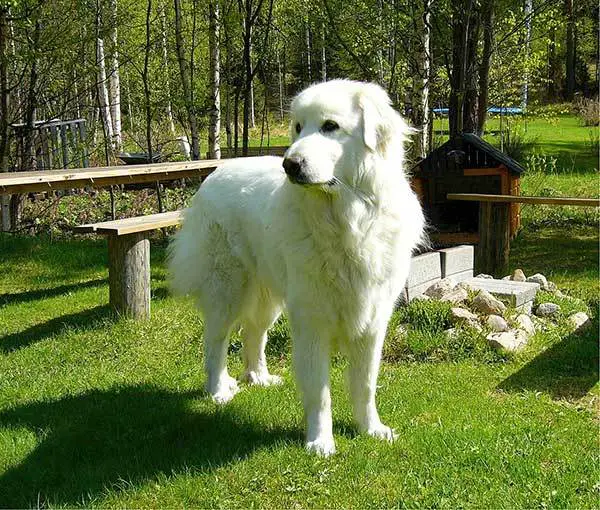
These gentle dogs are also good with children and other animals. They are great watchdogs and will react with aggression if their family is in danger.
However, they will only be aggressive only when they perceive danger. Most great Pyrenees are well-mannered and loving dogs who are devoted to their family and owners.
Blue Heeler History and Breed Overview
Blue Heelers are a cross between Collies and the iconic Wild Dingo from Australia.
Named Blue Heelers due to their stunning blue-colored coats, these dogs share their history with the Red Heelers, who also form part of the highly popular breed, the Australian Cattle Dog.
They were developed in the 19th century to help keep unruly cattle in check by nipping at their heels (hence their name).
While they are probably the world’s leading cattle herders, Blue Heelers make excellent family pets too.
It’s also important to note here that they rarely bark because of their Dingo ancestry, and they generally tend to be silent.
Today, Blue Heelers are loving family dogs that form strong bonds with their families.
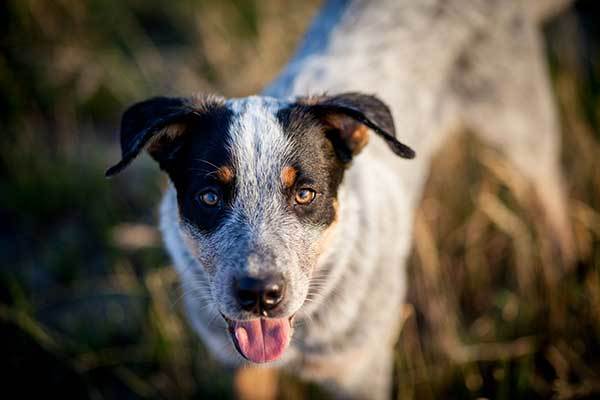
The General Appearance of the Blue Heeler Great Pyrenees Mix
So, what does a Great Pyrenees Blue Heeler Mix look like?
Since the Great Pyrenees Australian Cattle Dog Mix is a mixed breed, they can have several different combinations.
Since both parent breeds are large dogs, you can expect this mix to be a large dog as well. However, puppies even from the same litter might have different colors.
When it comes to their coat, they usually inherit their coat color from the Great Pyrenees: white, black and tan.
They often have solid coat colors, but they can have tricolored coats (Black & White, & Tan/Brown) like most of their Blue Heeler parents.
How Big Will A Blue Heeler Great Pyrenees Mix Get?
The parent breeds have different sizes and weights. The Great Pyrenees weighs around 85 to 115 pounds while the Blue Heeler weighs from 30 – 36 pounds.
This means that the Great Pyrenees can weigh up to 85 pounds more than the Blue Heeler. This makes an interesting hybrid dog.
Although the two parent breeds vary significantly in terms of size and weight, a full grown Great Pyrenees will be a large dog weighing around 61 to 100 pounds.
This large designer dog has a height of around 18 to 33 inches at the shoulders.
Blue Heeler Great Pyrenees Mix Behavior and Temperament
Given the personality of the two parent breeds, the Blue Heeler and Great Pyrenees Mix will be protective of their owner and family.
They should also be very active dogs who require regular physical and mental activity. If they are lonely or bored, they can become destructive.
Therefore, if you decide to bring this mix into your home, be ready to keep him occupied and tired. Once they are tired, they are less likely to get into trouble.
The Australian Blue Heeler Pyrenees Mix is intelligent, but he can also be stubborn. Positive and consistent training will help keep his independent streak in check.
This mix is not the best breed for novice owners, mainly because of their stubborn personality.
As you can see, this mix inherits a wide range of personality traits from both parent breeds. While their exact temperament of an individual dog may be quite difficult to predict, we know that this energetic dog requires plenty of attention.
They enjoy getting belly rubs and constant human interaction with his people.
Without proper training and socialization, Blue Heeler Pyrenees mixes may become quite aggressive towards unfamiliar people and show their dislike by nipping.
Since both parent breeds have natural herding instincts, they strongly protect their home and territory, which makes them great watchdogs and guard dogs.
However, a Blue Heeler Great Pyrenees Mix that is properly socialized from a young age is more likely to get along with cats and other animals.
They are also good with children and other dogs that they have been raised with.
They generally love to play outside with older children and large dogs. They also need to play in a secure, fenced-in yard that is safe for quality playtime.
Since Blue Heelers don’t get along well with small pets, however, it’s important to start socializing your puppy early.
Exercise Needs
The Great Pyrenees Blue Heeler Mix can be a great family pet for the right household.
This mix is best suited for an active home that is able to provide them with the physical activity and mental stimulation they need.
Exercise for this mix is not just about spending their energy, It also involves providing mental stimulation and giving them a job to do. This is yet another reason why this mix is not ideal for first time dog owners.
For mental stimulation, provide them with a truly stimulating environment with plenty of interactive dogs to help keep their curiosity under control.
The minimum amount of exercise your Great Pyrenees Heeler Mix will need is one to two hours each day.
The best ways of exercising this mix include daily walks, quality playtime and mental enrichment.
Moreover, these dogs were developed to work alongside their handlers and therefore, they enjoy human company.
If your Great Pyrenees Blue Heeler Mix is left alone for long periods of time, he can become bored and destructive.
- RICH FEEDING GAME – Look at the Big Orange Flower in the middle of the snuffle mat dog puzzle toys. Total 4 layers of orange petals can hide large…
- EXTRA FUN ATTRACTS YOUR PUPPY – We are extremely positive of our snuffle mat. But in order to provide more fun for lovely puppies, we set up 4…
- EXCELLENT RELEASE BUCKLE DESIGN – Have you ever bought a snuffle mat for your dog that want to develop good habits in your dog. But your dog likes…
Last update on 2025-01-13 / Affiliate links / Images from Amazon Product Advertising API
Training
Training a Great Pyrenees Blue Heeler Mix is a must, but it can be an enjoyable process for both you and your pooch if you follow a few important steps.
First and foremost, make sure you’re keeping your pup busy. Boredom is one of the most common causes of behavioral issues in dogs.
Since they need to be kept busy, you’ll find numerous opportunities to train your puppy. This will also give you more opportunities to set boundaries through a well-planned system of fun activities.
Whether it’s housetraining or fun playtime, this designer dog should become a well-mannered member of your family within a short period of time.
Since this cross is smart, training should not be all that difficult. These pups are happy to learn new tricks and enjoy pleasing their owners. However, you need to start training your pet early, so they don’t become too stubborn.
It is also important to use various positive reinforcements when training your pooch. Reward acceptable behaviors with plenty of treats and complements.
Although these pups can be sweet and gentle in nature, it’s also important to socialize them early. This will make a huge difference when they mature and become an integral part of your family.
Do They Shed?
Both parent breeds are known to shed, so the Blue Heeler Great Pyrenees Mix is not hypoallergenic.
As a dog owner, however, you can reduce the shedding by grooming your pooch regularly.
Grooming
This mix has a double coat, so you should brush him a few times per week to help keep them in good condition for a longer period.
The next thing you should do to help your dog achieve clean and healthy hair is to make periodic visits to a professional groomer. This should be done approximately once a month depending on the rate at which your dog’s hair grows.
If your Blue Heeler Great Pyrenees Mix takes after the Blue Heeler parent, then his coat should be quite resistant to grime and dirt.
This means you don’t need to bathe them too frequently. Instead, you can use deodorizing wipes for dogs to help keep their coat in tiptop condition.
Monitor their coat and pay special attention to any dry parts to determine if you are over-bathing your pup.
It is also recommended to keep an eye out on your pet’s ears. Long hair can grow around a Blue Heeler Great Pyrenees dog’s ears, which can end up accumulating a lot of dirt that can lead to an ear infection.
Trim their nails as necessary, and brush their teeth a few times each week as well.
Diet and feeding
Due to their large size, Blue Heeler Great Pyrenees Mixes will require a lot of high quality dog food.
However, do not overfeed your dog as this can cause obesity.
You can divide his food into two to three meals per day. You can choose a quality automatic dog feeder to help make feeding easier and more convenient.
It is also important to add probiotics and Omega 3 supplements like the pure wild Alaskan salmon oil to your dog’s diet to help boost healthy bone development and improve their overall health.
Select a high quality dog food that will offer nutrients that help in healthy bone development. Since these dogs are prone to joint issues, you should not take this advice lightly.
You can feed your Blue Heeler Great Pyrenees dog commercially-manufactured foods. Just make sure it’s rich in omega-3 and 6 fatty acids to help keep their coat luxurious. Moreover, always make sure fresh water is available.
Lifespan
The average life expectancy of a Great Pyrenees Blue Heeler Mix is around 10 to 16 years, depending on the diet, lifestyle, veterinary care, vaccinations, and more importantly, the dominant genes.
Great Pyrenees Blue Heeler Mix Health Issues
This mix is like any other designer dog that inherits health issues from the parent dogs. That’s why you should make sure you’re buying your puppy from a reputable breeder.
It is also advisable to ask all the questions you may have before meeting the puppy and helplessly falling in love with each other at first sight.
Some of the most common genetic health problems in Blue Heeler Great Pyrenees Mixes are bloat, joint issues, hip dysplasia and skin issues.
So, be always on the lookout for these issues. And if you notice anything unusual, call your vet immediately.
- ACTIONABLE HEALTH INSIGHTS: Test for over 270 genetic health conditions and get actionable insights to help you give your pup the best care possible….
- MOST ACCURATE BREED IDENTIFICATION: Test for over 350 dog breeds including dingoes, coyotes, wolves, and village dogs. Using a research-grade…
- TRAIT INSIGHTS THAT HELP YOU BE MORE PREPARED: Test for 55 physical traits. Size, coat, grooming needs — your dog’s traits don’t just make them…
Last update on 2025-01-13 / Affiliate links / Images from Amazon Product Advertising API
Great Pyrenees Blue Heeler Mix for Adoption
The pairing between a Blue Heeler and a Great Pyrenees is very rare, but you may be lucky enough to find this designer dog in a rescue.
Generally, adoption fees are far much less than you would pay a reputable breeder.
Moreover, most rescue animals have already visited the vet for a checkup, are neutered or sprayed and have had a round of crucial vaccinations. That can save you a great deal of money.
You’ll also become a hero when you give a rescue pup a forever home. One pet adopted from a rescue or animal shelter paves the way for another needy one to find a loving home.
Great Pyrenees Blue Heeler Mix for Sale and Price
The beautiful Great Pyrenees Blue Heeler Mix puppies can cost a few hundred dollars up to a thousand dollars (or even more).
It’s important to learn as much as possible about the puppy’s parent dogs as well as the breeders raising them.
That way, you can avoid buying a puppy from a backyard breeder or puppy mill masquerading as a responsible breeder.
A reputable breeder of Great Pyrenees Heeler puppies should be happy to provide you with all the information you need, including the health history of the parent dogs.
Apart from the cost of buying a puppy, you want to factor in food costs, vet fees and pet products like the MidWest Folding Crate for large dogs and the Furhaven Orthopedic dog bed from reputable retailers like Amazon.
Conclusion
The Great Pyrenees Blue Heeler Mix is a large dog with a lot of personality. They love to express their love, loyalty and compassion to their families.
Providing them with a good living environment, proper training and care will lead to a happy and healthy family pet. In return, your pooch will bring so much joy into your family.
Checkout Our Favorite Dog Products
1. BEST PUPPY TOY
We Like: Snuggle Behavior Toy with Heart Beat & Heat Pack – Ideal toy for new puppies.
2. BEST DOG TRAINING PROGRAM
We Like: Doggy Dan The Online Dog Trainer – Stop any dog problem and raise the perfect puppy with The Online Dog Trainer.
3. BEST DOG PUZZLE TOY
We Like: Outward Hound Interactive Puzzle Toy – Every dog loves chasing squirrels at the park. The Outward Hound Hide-a-Squirrel Puzzle Toy gives your dog the same feeling as though he was outdoors chasing live squirrels.
4. Best Bone Broth for Dogs
We Like: (Solid Gold – Human Grade Bone Broth for Dogs) – Simmered Beef Bone Broth With Turmeric Provides A Nutrient-Dense And Flavorful Addition To Your Dog’s Meal + Rich In Natural Collagen From Beef Bones.
5. Best Multivitamin for Dogs
We Like: PetHonesty 10-For-1 Multivitamin – 10 Benefits in 1 Daily Treat – These Multivitamin Snacks combine a well-rounded blend of the most essential vitamins and supplements including glucosamine, probiotics, vitamins and omegas, for dogs’ overall daily health.

